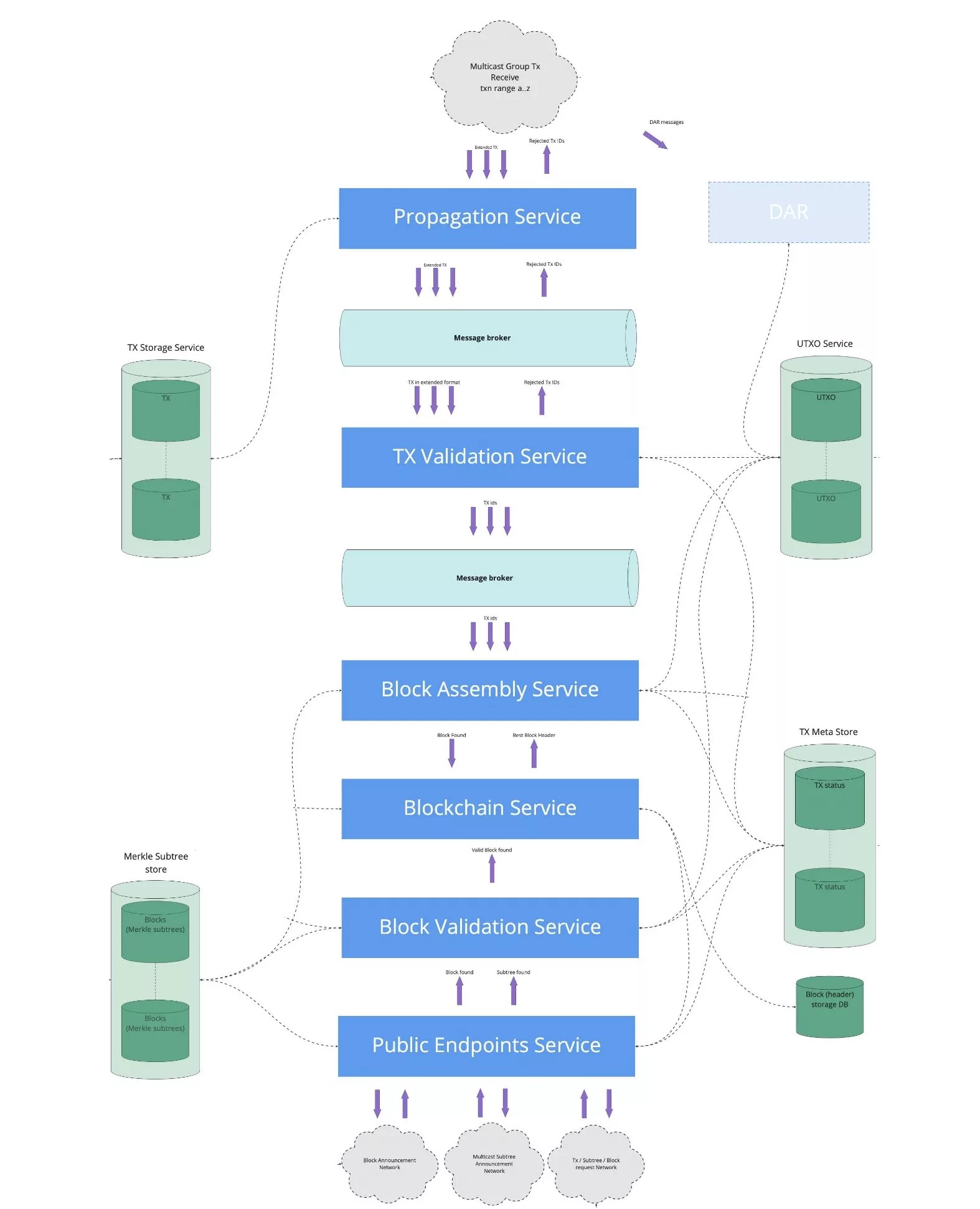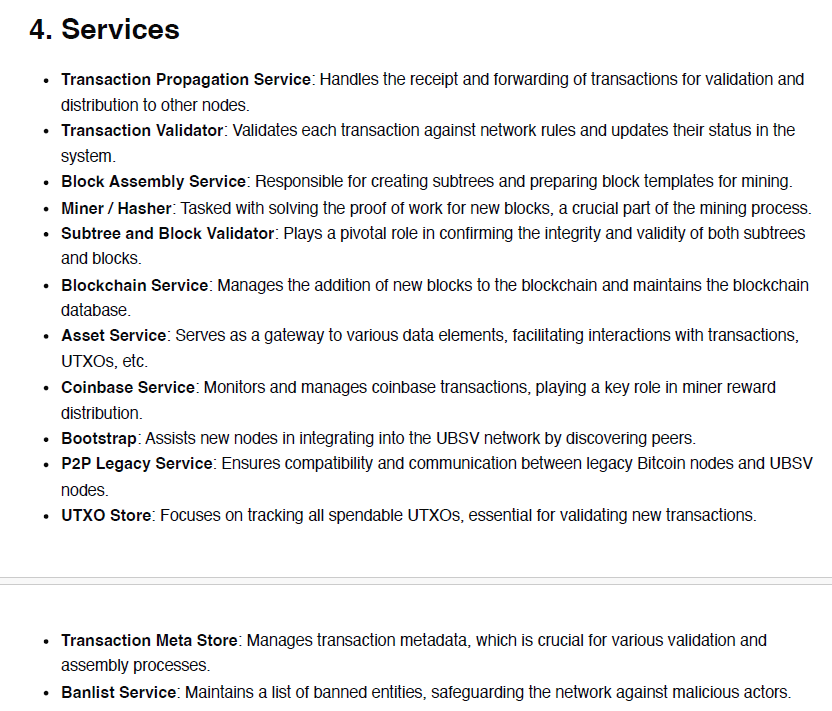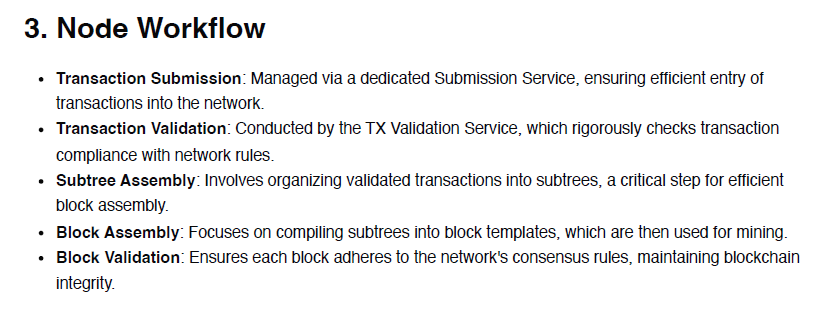|
Getting your Trinity Audio player ready...
|
It’s time for the BSV Blockchain to start taking on giants like VISA (NASDAQ: V) and Mastercard (NASDAQ: MA). The Teranode development team today announced new design features that will give a major boost to the network’s efficiency and speed, pushing BSV’s capabilities to a million transactions per second and far beyond.
The announcements, from protocol custodian BSV Blockchain Association, reveal a more service-oriented approach to the way the network works. The new features include “modularized” functions like transaction and block validation, and block assembly, into services that run only when required. Additionally, individual transactions in each block will be segmented into “subtree” batches of transactions that can be shared around the network for nodes to inspect, even while the block is still being mined.
Teranode, due to begin an initial six-month sustained test this month, is a major upgrade for the Bitcoin node software. It’s a ground-up rewrite of BSV blockchain’s architecture, designed to scale horizontally and provide new microservices for developers, applications and users—while still following all the fundamental rules Satoshi Nakamoto set for Bitcoin in 15 years ago.
The Teranode upgrade is critical for the BSV blockchain to scale unboundedly, and become even faster and cheaper for everyone to use.
There is little, if any, competition to equal Teranode in the wider blockchain world. The Bitcoin protocol has proven its reliability now for 15 years, and Teranode allows it to challenge not only the world’s major payment networks, but the entire internet and a rapidly-expanding digital economy.
Teranode microservices and subtrees share BSV’s work around
The true beauty of these modularized services and transaction subtrees is in their ability to work together. Machines on the network can perform different tasks concurrently rather than in a series of steps. This horizontal approach to scaling means the larger the network grows (i.e., the more hashing power applied to processing data) the more efficient it becomes.
There are at least 14 “microservices” in Teranode that each handle different network and validation functions. The list includes node services like propagation and transaction validation, block assembly and block validation. Overlay services include a Legacy P2P Network Bridge, a Peer Service, a UTXO Lookup Service, banlists, and transaction submission (ARC). A Message Broker takes care of communication between the services, and a TX Status Store tracks the status (and other meta data) of transactions within the system.

Teranode’s new architecture means that if one service comes under heavy load, transaction processors can apply additional computing resources to support that particular service, separate to any other services running on the same node.

Subtrees mean transactions can be “pre-approved,” making validation much quicker and closer to real-time. Including only the TXID in a subtree batch is a lightweight approach that assumes network nodes already have the full transaction data once a transaction is created and broadcast. Nodes can confirm they’re aware of all relevant transactions without needing to rebroadcast the same data repeatedly.
Instead of waiting for a transaction to be approved 10 minutes after it’s confirmed by miners (the current way Bitcoin functions), senders and recipients can be confident their transaction will clear within seconds. This is a huge improvement in speed and security, and addresses one of the key criticisms directed at Bitcoin and blockchain—that waiting for transaction validation makes the network too slow to function as a realistic digital payments system.

Unbounded BSV is now the only answer for the digital economy
Unbounded BSV can scale to any size needed while maintaining speed and the lowest-possible fees for using the network. This contrasts to the artificially-limited network known as “BTC,” which limits transaction block sizes to 1MB each. Despite media and social hype claiming BTC is a “money of the future,” the network cannot actually be used as money since it can only process 3-7 transactions per second in total. This artificial limitation has created high fees and long waits, and stunted innovation that might have allowed BTC to scale at all (even if BTC were to suddenly increase block sizes, its network software could not deal with millions of transactions a second).
| Feature | BTC | Teranode |
| Transactions | Standard Bitcoin transaction model. | Adopts an extended format with extra metadata, improving processing efficiency. |
| SubTrees | Not used. | A novel concept in Teranode, serving as an intermediary for holding transaction IDs and their Merkle roots. Each subtree contains 1 million transactions. Subtrees are broadcast every second. Broadcast frequently for faster and continuous data propagation. |
| Blocks | Transactions are grouped into blocks. Direct transaction data is stored in the block. Each block is linked to the previous one by a cryptographic hash, forming a secure, chronological chain. | Differ from traditional Bitcoin blocks by containing subtree identifiers instead of direct transaction data, streamlining validation processes. |
| Block Size | Originally capped at 1MB, restricting transactions per block. | Current BSV expands to 4GB, increasing transaction capacity. Teranode removes size limit, enabling limitless transactions per block. |
| Processed Transactions per second | 3.3 to 7 transactions per second. | Guarantees a minimum of 1 million transactions per second (this is more than 100,000 times faster than BTC). |
Advantages of the Teranode Model. (Source: BSV Blockchain Association)
The digital economy is insatiable for data and requires a network that can process it all quickly while keeping it secure. The BSV blockchain is simultaneously a global digital payments network and one that can handle any volume of additional data, from rudimentary IoT devices to enterprise- and government-tier contracts.
Watch: How Teranode enables unbounded scaling

 12-13-2025
12-13-2025 





